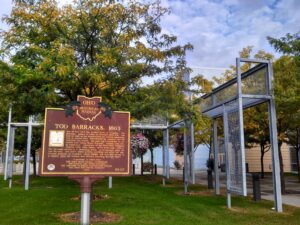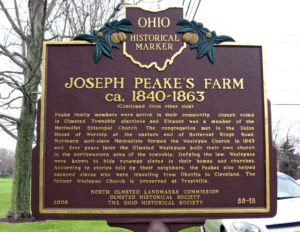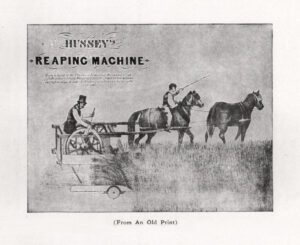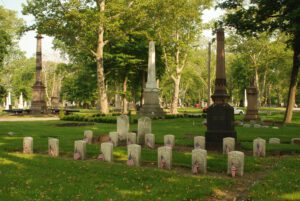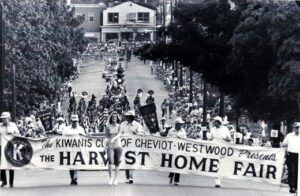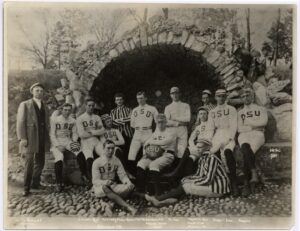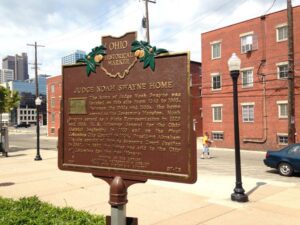, OH
One of five Civil War military posts in Columbus, Tod Barracks, named in honor of Governor David Tod, was built in 1863 as the headquarters for military administration in central Ohio. Necessitated by Lincoln’s call for 300,000 new troops, the post was constructed in two months with United States Engineer, Captain John Tod, as supervisor. Carpenters of the 88th Ohio Volunteer Infantry from Camp Chase, three miles west, built it. Tod Barracks served as a recruiting depot, a rendezvous point for new recruits, and place where soldiers mustered-out after the war. Located adjacent to Columbus’ Union Station, the post also served as a transfer point for soldiers and officers traveling through Ohio. (continued on other side)
, OH
Joseph Peake was born in Pennsylvania in 1792 and came to Ohio in 1809 with his parents and brother. They were the first African Americans to settle permanently in the Cleveland area. He was the son of George Peake, a runaway slave from Maryland, who fought on the British side at the Battle of Quebec in 1759 during the French and Indian War. A man with some means and talent, George Peake invented a stone hand mill for grinding corn, a labor-saving device that endeared the Peakes to their neighbors in western Cuyahoga County. Joseph Peake and his wife Eleanor, an African American from Delaware, bought land in the 1840s on the Mastick Plank Road and built a home near this marker. [Continued on other side]
, OH
Mechanical reapers enabled farmers to harvest much more grain than they could by sickle or scythe. In June 1835, in a field 800 feet southeast of Mill Creek, inventor Obed Hussey (1791-1860) tested what he upheld as the first successful reaper. Blacksmith John Lane, miller Jediah Hill, Hill’s son-in-law Henry Rogers, brothers Algernon and Thomas Foster, and others observed the test, the culmination of Hussey’s experiments with prototypes since the early 1830s. Hussey’s patent for a reaper in 1833 predated that of his competitor Cyrus McCormick (1809-1884) applied for in 1834. Initially, some preferred Hussey’s reaper to McCormick’s, although McCormick’s machines eventually dominated the field. In the late 1850s, Hussey and others sued McCormick for patent infringement and won, compelling the payment of damages by McCormick.
, OH
Howard Daniels, who lived from 1815-1863, was a noted architect and landscape gardener. Over the course of his life, he designed six Ohio and New York cemeteries, including Woodland that began in 1852 when he laid out 20 of its 60 acres into fashionable “rural cemetery” style. Later acreage in the cemetery adapted his curvilinear design. “As beautifully prepared for a burial place as fancy and taste could desire,” Woodland was dedicated on June 14, 1853, and became Cleveland’s primary cemetery. An ornate gatehouse, chapel, and fountains came later. Generations of Clevelanders, pioneering and prominent, as well as veterans onward from the War of 1812, are buried here. For more than a century, Woodland, in its original and newly platted sections, has embraced people from every race, the rich and poor, natives and immigrants, and the famous and obscure. It has truly become a community cemetery. [continued on other side]
, OH
In 1804, Enoch (1764-1817) and Achsah (c.1767-1839) Carson and their seven children journeyd from New Jersey to Cincinnati. In 1805, they settled in the western hills in a large grove near Beech Flats, in what would become Green Township in 1809 and Cheviot in 1818. Game was plentiful and fertile soil yielded abundant crops. By 1806, Carson had cleared and cultivated nearly 20 acres of his land. That fall, he began a tradition that has continued into the 21st century. Echoing the ancient custom of harvest home, Carson brought together a fledging community to celebrate its good fortune and abundant harvests. Each passing year the community gathered in Carson’s grove to give thanks, rejoice, and uphold the tradition of harvest home. (Continued on other side)
, OH
In the fall, life for many in Columbus revolves around Ohio State University football, from the first kickoff in September to the last play in November. O.S.U.’s first home game took place at 2:30 P.M. on November 1, 1890. The Ohio State University played the University of Wooster on this site, which was then called Recreation Park. Just east of historic German Village, the park occupied the north side of Schiller (now Whittier) between Ebner and Jaeger in what is now Schumacher Place. The weather was perfect, and the crowd reportedly included a number of women, who cheered loudly. Nonetheless, O.S.U. lost to Wooster 64-0. Wooster, physically fit for the game, showed O.S.U. that training is critical to winning. The tradition of training continues. Today, on football Saturdays in Ohio Stadium on Woody Hayes Drive, the sound of an O.S.U. home game can be heard around the world.
, OH
The first tax supported free public library in Columbus was formed in 1873 and housed in City Hall. In 1901, City Librarian John Pugh petitioned Andrew Carnegie for funding and was granted $200,000. In 1903, the Swayne home was razed and construction began. The library opened to the public on April 4, 1907. The library’s purpose is inscribed on the front of the building – Bibliotheca Fons Eruditionis: The library is a fountain of learning; Our Treasures Are Within; and Open To All.
, OH
Chestnut Street Cemetery is the first Jewish cemetery in Ohio and the earliest west of the Allegheny Mountains. It was established in 1821 when Nicholas Longworth sold land to Joseph Jonas, David I. Johnson, Morris Moses, Moses Nathan, Abraham Jonas, and Solomon Moses for $75 as a “burying ground.” Benjamin Lape (or Leib) was the first buried there with Jewish rites. The purchase of the original plot marks the beginning of an organized Jewish community in the Queen City. Chestnut Street Cemetery, although enlarged by adjacent purchases, closed in 1849 when cholera ravaged the city and filled available space. In all, there are approximately 100 interments on the site. Jewish Cemeteries of Greater Cincinnati maintains Chestnut Street Cemetery as well as many other Jewish cemeteries in the region.


